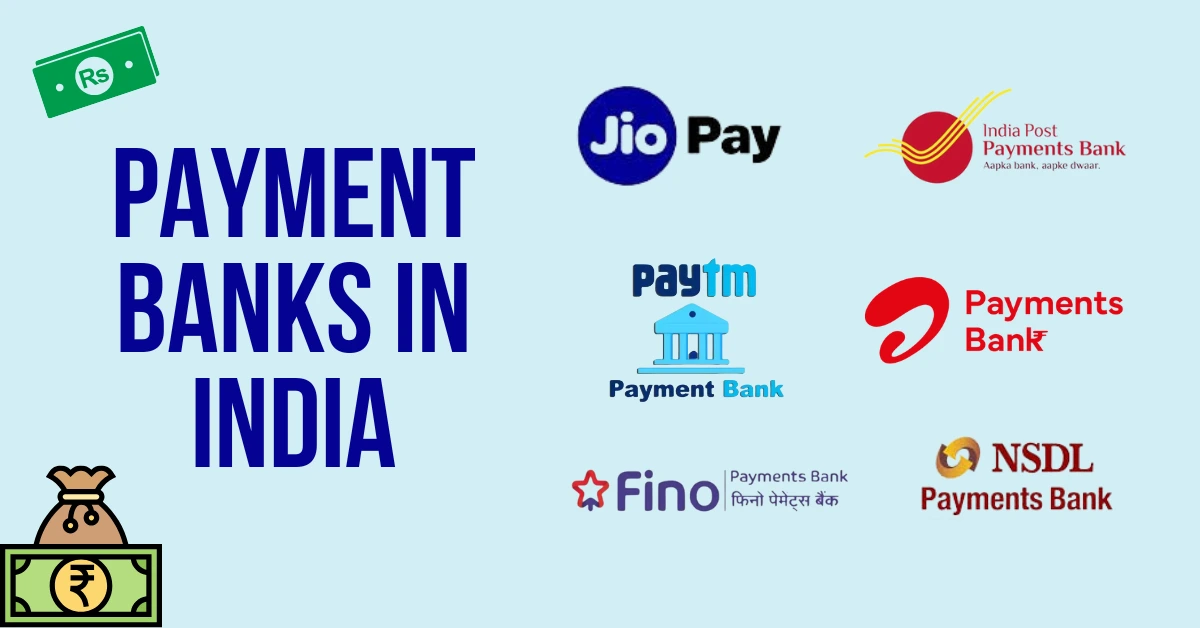What Are Digital Payment Banks?
Digital payment banks work completely online, meaning you don’t have to visit a physical bank. You can open a savings account, pay bills, recharge your mobile, transfer money, and manage your finances using just your phone or computer. Their main aim is to make banking easier and more accessible for everyone.
Unlike regular banks, digital payment banks don’t offer loans or credit cards. They focus on simple banking services like accepting deposits (up to Rs. 2 lakh per account) and making digital payments quick and secure. Everything is done through an app or website, making it perfect for people who prefer online banking.
These banks are especially useful for people living in areas where traditional banks might be hard to reach. By bringing banking online, digital payment banks make it faster, easier, and more convenient for everyone to manage their money from anywhere, at any time.
Difference Between Payment Banks and Regular Banks
| Feature | Payment Banks | Regular Banks |
|---|---|---|
| Main function | Offers basic banking facilities like account opening, cash deposit, money transfer etc | Offers all the banking services like loans, credit facilities, passbook printing and much more |
| Deposits Limit | Can accept deposits up to Rs. 2 lakh per account. | No limit on how much you can deposit. |
| Loans and Credit | Can not offer loans or credit cards | Can give out loans, offer credit cards, and other financial products. |
| Physical Branches | Mostly operates online with few or no branches. | Have physical branches for customers to visit. |
| Interest on Deposits | Offer interest on deposits, but rates may be lower than regular banks. | Offer interest on savings accounts and fixed deposits, often at higher rates. |
Target Audience | Focus on people with limited access to traditional banking, especially in rural areas. | Serve all types of customers, including individuals, businesses, and corporations. |
| Services Offered | Basic services like deposits, mobile recharges, bill payments, and money transfers. | Full banking services like investments, loans, fixed deposits, insurance, and more. |
| Accessibility | Primarily through mobile apps or websites, making banking easier and more digital. | Primarily through mobile apps or websites, which make banking easier and more digital. |
| Government Regulations | More restrictions on activities to keep risks low. | Fewer restrictions and more freedom to operate various financial services. |
Best Payment Banks in India
Below is the list of some of the best payment banks in India.
1. Airtel Payments Bank
Airtel Payments Bank is one of the first payment banks in India. It allows users to open savings accounts, make cashless transactions, and earn interest on deposits. With a wide reach across rural and urban areas, it enables users to access banking services even in remote locations.

2. Paytm Payments Bank

Paytm Payments Bank offers a seamless digital banking experience. It provides zero balance savings accounts, fixed deposits, and various digital payment options. Paytm’s vast ecosystem allows users to make easy payments, pay bills, and shop online effortlessly.
3. India Post Payments Bank (IPPB)

India Post Payments Bank, backed by the government, leverages the extensive postal network to deliver banking services across the country. It offers savings accounts, money transfers, and doorstep banking, focusing on financial inclusion, especially in rural areas.
4. Fino Payments Bank

Fino Payments Bank is known for its strong presence in rural and semi-urban areas. It provides convenient banking services, including account opening, money transfers, and bill payments. Fino also offers mobile banking to help users manage their finances on the go.
5. Jio Payments Bank

Jio Payments Bank, a collaboration between Reliance Jio and SBI, integrates digital banking with Jio’s telecom services. It offers services like savings accounts, money transfers, and bill payments through its digital platform, aiming to enhance the digital banking experience.
These payment banks are key in promoting cashless transactions and expanding banking services nationwide.

How Many Payment Banks in India
As of now, there are six payment banks in India. Payment banks are a type of bank that helps people access basic banking services like opening a savings account, sending or receiving money, and paying bills, all without needing a full-service bank. These banks focus on making banking easy and accessible, especially for those who may not have a regular bank account.
Here are the six payment banks in India:
- Airtel Payments Bank
- Paytm Payments Bank
- India Post Payments Bank (IPPB)
- Fino Payments Bank
- Jio Payments Bank
- NSDL Payments Bank
These banks aim to reach more people, including those in rural and remote areas, and make it simple for everyone to use banking services.
Also read – Best Bank to Open Savings Account Online
Advantages & Disadvantages of Payment Banks
Advantages of Payment Banks
- Easy Account Opening
Payment banks allow you to open an account quickly with just your mobile number and basic details. No need for too much paperwork. - No Minimum Balance Required
Most payment banks do not ask for a minimum balance, so you can keep even a small amount in your account without any worries. - Simple Digital Transactions
You can easily send or receive money, pay bills, and shop online using apps provided by payment banks. It’s all at your fingertips. - Wide Reach in Rural Areas
Payment banks are available even in remote and rural areas, helping people access banking services where regular banks are hard to find. - Interest on Savings
You can earn some interest on the money you keep in your payment bank account, just like in regular savings accounts. - Cashless Transactions
Payment banks promote cashless transactions, making it easy for you to pay using your phone without carrying cash.
Disadvantages of Payment Banks
- Limited Services
Unlike regular banks, payment banks cannot provide loans, credit cards, or overdraft facilities. They mainly focus on basic banking services. - Deposit Limit
There is a limit on how much money you can keep in a payment bank account. Currently, it’s up to ₹2 lakh per account, which may not be suitable for everyone. - No Physical Branches
Some payment banks may not have many physical branches, so all services are mainly digital. It could be a problem for those who prefer in-person banking. - Dependence on Digital Platforms
If you are not comfortable using digital platforms or smartphones, you might find it a bit challenging to use payment banks. - Less Variety of Investment Options
Payment banks do not offer fixed deposits, mutual funds, or other investment options like traditional banks. They mainly focus on easy, basic banking.
Conclusion
Payment banks are a great option for those looking for simple and easy banking services. They make it easy to open accounts, send money, and pay bills, especially for people who might not have access to traditional banks. With no need for a minimum balance and quick digital transactions, they’re a convenient way to manage your money. However, they do have some limitations, like deposit limits and fewer services compared to regular banks.

If you mainly need a basic account to handle your daily transactions and don’t need loans or complex banking, then payment banks can be a helpful solution. But if you require more advanced banking features, you might need to look at regular banks.
Also read – Digital Payment Frauds in India






